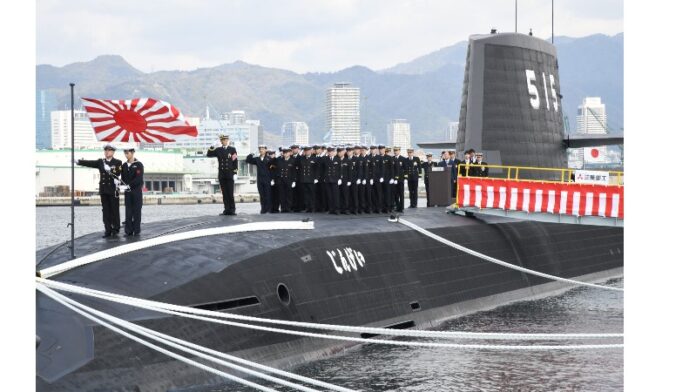
 The JS Jingei, the second submarine of the JMSDF’s Taigei-class, is powered by diesel-electric propulsion – a technology now part of the debate in Japan regarding nuclear-powered submarines.
The JS Jingei, the second submarine of the JMSDF’s Taigei-class, is powered by diesel-electric propulsion – a technology now part of the debate in Japan regarding nuclear-powered submarines.
On September 19, an expert panel convened by Japan’s Ministry of Defense released recommendations on how the country should fundamentally strengthen its defense capabilities in response to China’s expanding military presence in the Pacific, Russia’s ongoing invasion of Ukraine, and both countries’ cooperation with North Korea.
Established in February 2024 under the Headquarters for the Realization of Fundamental Reinforcement of Defense Capabilities, headed by the Minister of Defense, the Expert Panel has issued a total of six recommendations.[1] These include enhancing deterrence and response capabilities, acquiring advanced technologies (e.g., unmanned systems and AI), strengthening of the U.S.–Japan alliance and ties with like-minded partners, securing supply chains through export-driven policies, positioning defense as an economic driver, and a “2% of GDP” benchmark alongside increased flexibility in the review cycle for Japan’s Defense Buildup Plan of 2022.
A specific element of the report that has generated debate in Japan is a seemingly implicit suggestion that the country consider the acquisition of nuclear-powered submarines alongside the diesel-electric vessels that are currently in service.
The Expert Panel’s Apparent Call for Nuclear-Powered Submarines
The Expert Panel, composed of 17 members including Chairman Sadayuki SAKAKIBARA, Honorary Chairman of Keidanren, and Shinichi KITAOKA, Professor Emeritus at the University of Tokyo, specifically stated that submarines equipped with Vertical Launching Systems (VLS) capable of deploying stand-off missiles (as announced by JMOD in the 2022 Defense Buildup Program) should possess “long-distance and sustained-duration navigation and submersion.”[2]
To this end, the Japan Ministry of Defense (JMOD) is encouraged to pursue research and development into “next-generation propulsion systems, without being constrained by conventional wisdom”[3] (emphasis added by the author).
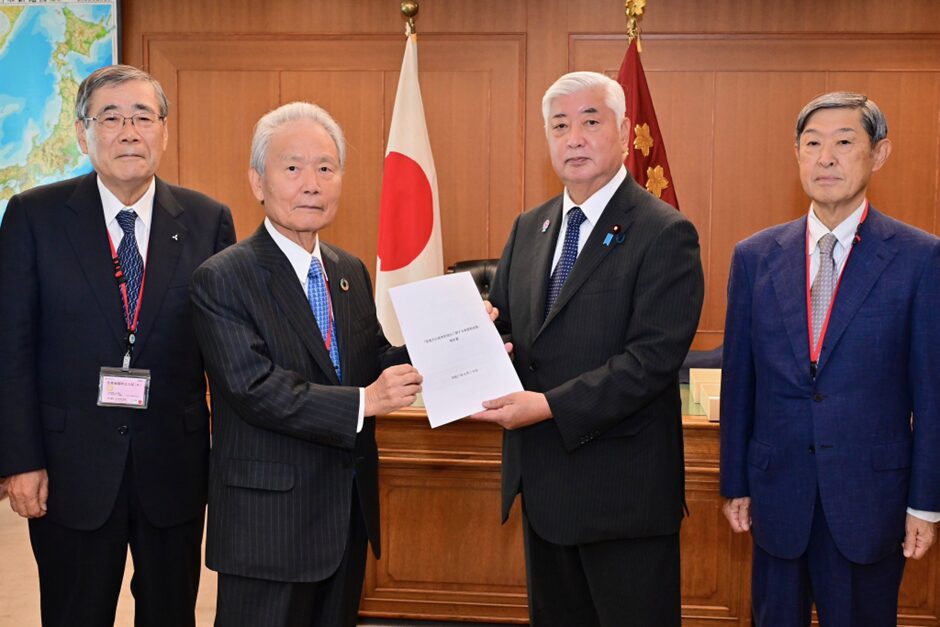
 The Expert Panel on Fundamental Reinforcement of Defense Capabilities submitting its report to Japanese Defense Minister Gen NAKATANI on September 19, 2025.
The Expert Panel on Fundamental Reinforcement of Defense Capabilities submitting its report to Japanese Defense Minister Gen NAKATANI on September 19, 2025.
According to the Asahi Shimbun, prior panel discussions indicate that such a propulsion system would include the use of “compact nuclear reactors.[4]
Meanwhile, the Sankei Shimbun suggests that this does not mean the panel has ruled out alternative technologies, such as advanced solid-state batteries and fuel cells, to extend the range of Japan’s fleet of diesel-electric submarines.[5]
Japan and Making the Case for Nuclear-Powered Submarines
The notion of acquiring nuclear-powered submarines is not new in Japan. Just last year, during the Liberal Democratic Party (LDP) leadership election, lawmaker KONO Taro proposed that Japan consider acquiring nuclear-powered submarines capable of long-duration submersion to counter attempts to pass through the East China Sea into the wider Asia-Pacific. He also suggested exploring the possibility of Japan joining AUKUS.[6]
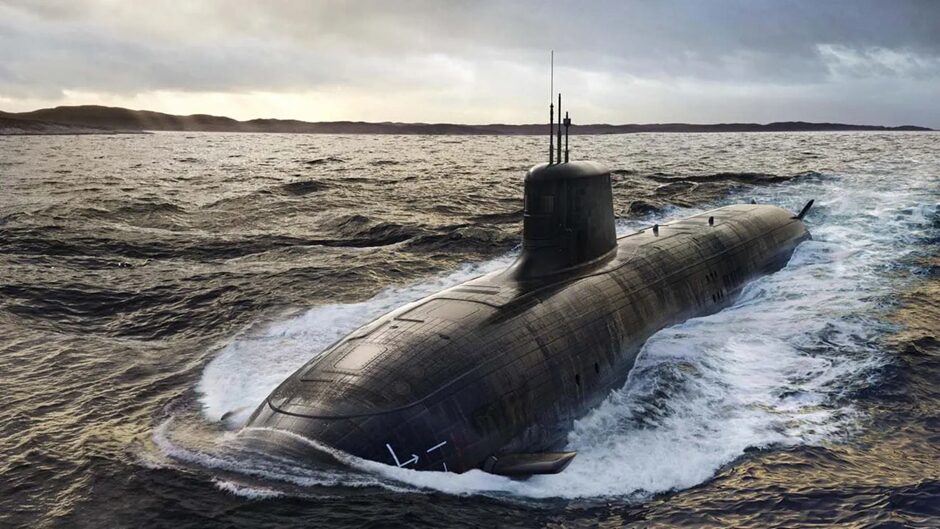
 Conceptual image of a conventionally armed, nuclear-powered submarine “SSN-AUKUS”, to be built in the UK and Australia to a British design incorporating advanced US submarine technology under the AUKUS partnership.
Conceptual image of a conventionally armed, nuclear-powered submarine “SSN-AUKUS”, to be built in the UK and Australia to a British design incorporating advanced US submarine technology under the AUKUS partnership.
The proposal of then Prime Minister–hopeful KONO, however, was rejected as unfeasible by the Fumio KISHIDA government at the time. Officials emphasized that, under the prevailing interpretation of Japan’s Atomic Energy Basic Law (which restricts the use of nuclear energy to peaceful purposes), it would be legally difficult for Japan to acquire nuclear-powered submarines.
Nevertheless, the fact that both Russia and China (key adversaries that were identified in Japan’s Expert Panel report) operate such vessels, coupled with recent intelligence that North Korea may have acquired related technology from Russia,[7] likely influenced the panel’s decision to implicitly raise the issue of nuclear-powered submarines once again.
The Sankei Shimbun notes that nuclear-powered submarines provide far greater endurance and range than the conventional diesel-electric submarines currently operated by the Japan Maritime Self-Defense Forces (JMSDF).[8]
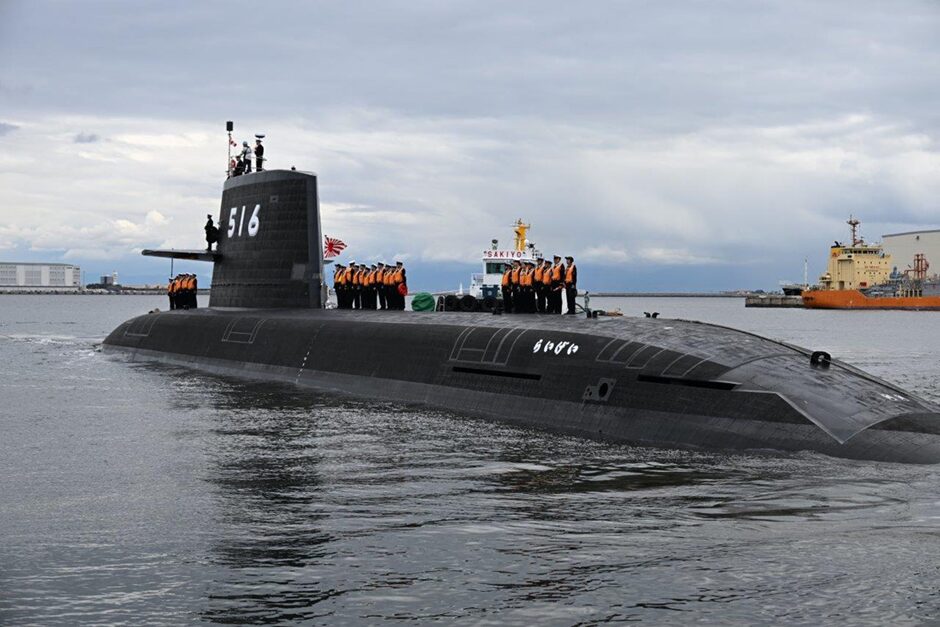
 JS Raigei (SS-516), the fourth diesel-electric submarine of the JMSDF’s Taigei Class.
JS Raigei (SS-516), the fourth diesel-electric submarine of the JMSDF’s Taigei Class.
Japan’s Taigei-class attack submarines, the largest in the JMSDF fleet, do incorporate a key innovation designed to overcome the limitations of traditional diesel-electric systems: lithium-ion batteries. This advanced technology reduces weight and complexity by eliminating the need for an air-independent propulsion (AIP) system, while providing greater underwater endurance, faster recharge times, and improved silent operation.[9]
Nevertheless, nuclear-powered submarines continue to retain a significant advantage, offering higher power output and eliminating the need for regular snorkeling to vent diesel exhaust and recharge batteries. Instead, the nuclear-powered option generates sustained propulsion using a compact onboard reactor, and latest designs are intended to operate for their entire service life without requiring refueling or fuel rod replacement.[10]
Moreover, diesel-electric submarines must be refueled by supply ships once their fuel is depleted, and the operational endurance of Japan’s vessels in this class is estimated at about one month. In contrast, nuclear-powered submarines can operate for roughly three months, constrained mainly by crew fatigue and food supplies.
Finally, while diesel-electric submarines are more affordable and retain advantages in stealth for coastal defense, nuclear-powered submarines offer far greater power projection that can enable the protection of major sea lines of communication (SLOCs), the conduct of sea-denial missions, and unmatched endurance and range across the open ocean.[11]
Japan’s Shift?: AUKUS, a Changing Security Environment, and Latent Issues
The advantages of nuclear-powered submarines proved crucial in Australia’s 2021 decision to scrap a deal with France for diesel-electric submarines in favor of AUKUS.
Nuclear-powered submarines can provide Australia with greater protection against distant threats such as long-range guided missiles, and enable Canberra to play a more proactive role in shaping the region, as well as to hedge against the relative decline of its U.S. ally.[12]

 U.S President Joe Biden (middle) with British Prime Minister Rishi Sunak (right) and Australia Prime Minister Anthony Albanese (left) at the announcement of the joint development of nuclear-powered submarine “SSN-AUKUS”, March 13, 2023.
U.S President Joe Biden (middle) with British Prime Minister Rishi Sunak (right) and Australia Prime Minister Anthony Albanese (left) at the announcement of the joint development of nuclear-powered submarine “SSN-AUKUS”, March 13, 2023.
Japan is facing a similar strategic calculation as Australia, informed by the JMSDF’s 2024 doctrine of shaping the security environment and deterring unilateral attempts to alter the status quo.[13] This is coupled with the view of the Expert Panel assembled by JMOD that Trump’s “America First” agenda likely signals a structural transformation in U.S. foreign policy rather than representing a transient phenomenon.[14]
Operationally, combining stealth with long-range endurance will be crucial to the effectiveness of JMOD’s planned submarines equipped with VLS capable of deploying standoff missiles.
Greater power and sustained speed of a nuclear-powered submarine would be significant in lowering the operational risk calculus of firing a missile by reducing the risk of detection and tracking after launch.[15]
However, a key sticking point here mentioned by Sankei is whether the JMSDF would be able to sustain the manpower required for extended submerged voyages, given that the force is already struggling with a shortage of crew members for its current vessels.
Moreover, cost is a major factor. The Japanese newspaper notes that the U.S. Navy’s latest nuclear submarines cost around 4 billion USD (about 600 billion yen), roughly five times more than Japan’s conventionally powered vessels that each cost about 120 billion yen (approx. 0.8 billion USD).
Finally, and perhaps most importantly, Japan faces legal restrictions on the use of nuclear energy for peaceful purposes. Here, defense officials have reportedly suggested that if the use of nuclear power in commercial vessels were to expand, there may be room to gain public support for reinterpreting the Atomic Energy Basic Law.[16]
Nevertheless, one obstacle to such an approach could be a negative perception of nuclear-powered vessels among the Japanese public, arising from a 1974 radiation leak accident involving Japan’s only nuclear-powered general cargo ship, the Mutsu,[17] which has since been converted into the diesel-electric oceanic research vessel Mirai.
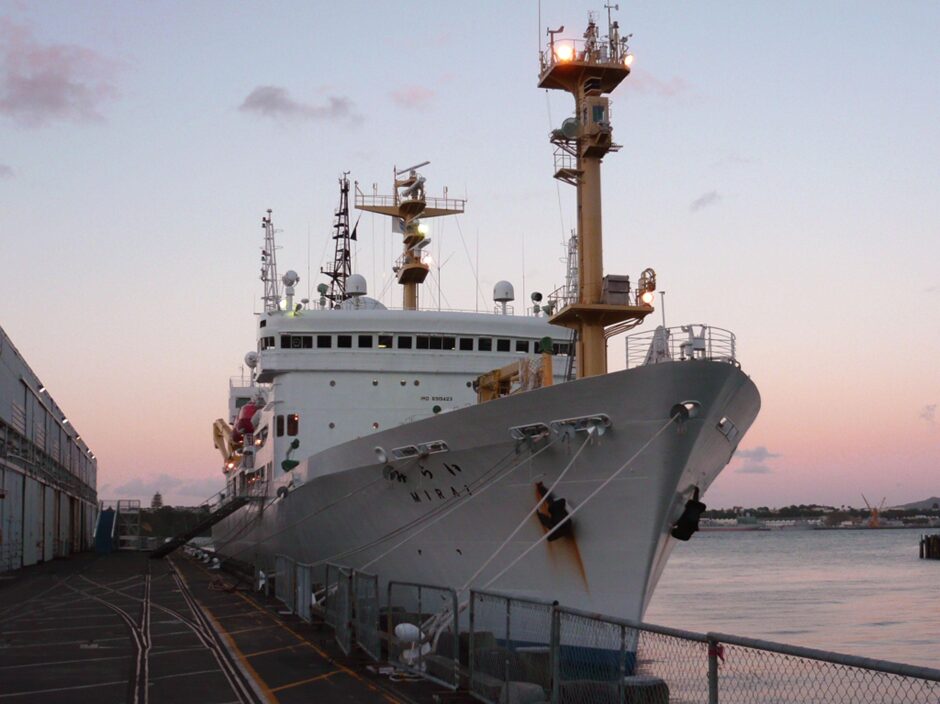
 The diesel-electric-powered Japanese research vessel, Mirai, formerly the nuclear-powered ship Mutsu decommissioned in 1992.
The diesel-electric-powered Japanese research vessel, Mirai, formerly the nuclear-powered ship Mutsu decommissioned in 1992.
Japan has conducted little research on maritime nuclear technology since the Mutsu project was terminated in the 1990s, although recent private-sector initiatives suggest that this may be starting to change.[18]
Thus, as one defense official has reportedly noted, given the high cost, gaining public support for a nuclear-powered submarine could face significant hurdles and may take more than ten years to achieve.[19]
Views in Japan’s Academia and Defense Expert Community
Japan’s academia and defense expert community has also weighed in on the relative costs and benefits of a nuclear-powered option.
Ken JIMBO, Professor of International Relations at Keio University, argued that the high costs of maintaining reactors, training personnel, and decommissioning make nuclear submarines impractical for Japan’s limited budget. He suggests they should only be considered if confidence in U.S. extended deterrence were seriously undermined, making nuclear forces a realistic national option for Japan.[20]
In contrast, Etsuro HONDA, a former Finance Ministry bureaucrat, has argued that with Japan’s improved fiscal outlook, which has provided about 10 trillion yen (approx. 66.8 billion USD) in annual leeway, nuclear-powered submarines are feasible. Fumio OTA, a former Director-General of the Defense Intelligence Headquarters, also advocates nuclear propulsion. He notes that while earlier generations of JMSDF “submarine experts” opposed the option due to their high cost and the force’s limited mission set of patrolling the Soya, Tsugaru, and Tsushima Straits, the growing threats from Russia, China, and North Korea have led newer generations to view them more favorably.[21]
Conclusions: AUKUS Cooperation as a Pathway?
The Expert Panel on Fundamental Reinforcement of Defense Capabilities, assembled in 2024 based on the National Security Strategy and other defense documents released in late 2022, has highlighted the need for a long-endurance VLS-equipped submarine capability.
While this is indeed likely to represent an implicit call for nuclear-powered submarines, numerous operational, legal and political hurdles remain. Notably, Japan’s industrial research and development into maritime nuclear propulsion systems has languished since the decommissioning of the Mutsu as the country’s only nuclear-propelled ship.
If Japan were to pursue nuclear-powered submarines, AUKUS technical cooperation – or even participation – could be an attractive option to help overcome some of these hurdles. Australia, the AUKUS nation that will be the main operator of the partnership’s SSN-AUKUS submarines, which are nuclear-powered but, importantly, conventionally armed, shares with Japan a longstanding commitment to the peaceful use of nuclear energy.[22]
Given that the Japanese Government has worked hard in recent years to promote to the public the need to enhance cooperation with Australia and the UK as like-minded partners committed to the rule of law AUKUS cooperation could act as a useful precedent to reinterpret Atomic Energy Basic Law.
Moreover, cooperation with AUKUS could go some way to help Japanese policy-makers reduce costs by pooling R&D and industrial cooperation as well as allay domestic concerns regarding the reliability of maritime nuclear propulsion, given that both the U.S. and UK have strong technological expertise in this area.
A major challenge in pursuing the AUKUS route, however, is winning assent from participating nations, especially the United States, where “America First” tendencies, highlighted by Japan’s Expert Panel, could be influential in the country’s ongoing review of the partnership.
Japan’s Defense Ministry now plans to closely consider the recommendations of the Expert Panel on Fundamental Reinforcement of Defense Capabilities.[23] These include the enhancement of cooperation with the U.S. and like-minded nations, as well as various measures to reduce restrictions on exporting defense equipment.
Notes:
*1 USD = 150 JPY
[1] An English-language summary of the recommendations is available at: https://www.mod.go.jp/j/policy/agenda/meeting/drastic-reinforcement/pdf/siryo06_01_en.pdf. For the full report (in Japanese), see: Japan Ministry of Defense, “「防衛力の抜本的強化に関する有識者会議」報告書” [Report by the “Expert Panel on Fundamental Reinforcement of Defense Capabilities”], September 19, 2025, https://www.mod.go.jp/j/policy/agenda/meeting/drastic-reinforcement/pdf/siryo06_02.pdf.
[2] Japan Ministry of Defense, “「防衛力の抜本的強化に関する有識者会議」報告書” [Report by the “Expert Panel on Fundamental Reinforcement of Defense Capabilities”], September 19, 2025, p.14 https://www.mod.go.jp/j/policy/agenda/meeting/drastic-reinforcement/pdf/siryo06_02.pdf.
[3] Ibid.
[4] Taro Ono and Mizuki Sato, “Experts support new SDF subs powered by nuclear reactor”. Asahi Shimbun, September 19, 2025, https://www.asahi.com/ajw/articles/16039175.
[5] Sankei Shimbun, “原潜は「圧倒的アドバンテージ」 太平洋進出の中国に対抗 コストや「法制面の壁」が課題” [Nuclear submarines an “overwhelming advantage” in countering China’s expansion into the Pacific, but cost and “legal barriers” are issues]. September 19, 2025, https://www.sankei.com/article/20250919-UCT5TU4L4NOKRAJJFIG2A27EMU/.
[6] Kyodo News, “Japan dismisses idea to get nuclear subs floated by LDP chief hopeful”, September 5, 2024, https://english.kyodonews.net/articles/-/50164.
[7] Korea JoongAng Daily, “Russia may have supplied North with nuclear reactor, South’s military says”, September 17, 2025, https://koreajoongangdaily.joins.com/news/2025-09-17/national/northKorea/Russia-may-have-supplied-North-with-nuclear-reactor-Souths-military-says/2400938.
[8] Sankei Shimbun, “原潜は「圧倒的アドバンテージ」 太平洋進出の中国に対抗 コストや「法制面の壁」が課題”, [Nuclear submarines an “overwhelming advantage” in countering China’s expansion into the Pacific, but cost and “legal barriers” are issues]. September 19, 2025, https://www.sankei.com/article/20250919-UCT5TU4L4NOKRAJJFIG2A27EMU/.
[9] Reuben Johnson, “Japan’s New Taigei-Class ‘Big Whale’ Submarines Have Just 1 Mission”. National Security Journal, May 23, 2025, https://nationalsecurityjournal.org/japans-new-taigei-class-big-whale-submarines-have-just-1-mission/.
[10] Sankei Shimbun, “原潜は「圧倒的アドバンテージ」 太平洋進出の中国に対抗 コストや「法制面の壁」が課題”, [Nuclear submarines an “overwhelming advantage” in countering China’s expansion into the Pacific, but cost and “legal barriers” are issues]. September 19, 2025, https://www.sankei.com/article/20250919-UCT5TU4L4NOKRAJJFIG2A27EMU/.
[11] Michael Walker and Austin Krusz, “There’s a Case for Diesels”. Proceedings, June 2018, https://www.usni.org/magazines/proceedings/2018/june/theres-case-diesels.
[12] Felix K. Chang, “Strategic Choice: Australia’s Nuclear-Powered Submarines”. Foreign Policy Research Institute, October 21, 2021, https://www.fpri.org/article/2021/10/strategic-choice-australias-nuclear-powered-submarines/.
[13] Japan Maritime Self-Defense Force, “JMSDF Capstone Doctrine (MDP 1)”, March 2, 2025, https://www.mod.go.jp/msdf/en/about/img/2024doctrine_en.pdf.
[14] Japan Ministry of Defense, “「防衛力の抜本的強化に関する有識者会議」報告書” [Report by the “Expert Panel on Fundamental Reinforcement of Defense Capabilities”], September 19, 2025, p.12, https://www.mod.go.jp/j/policy/agenda/meeting/drastic-reinforcement/pdf/siryo06_02.pdf.
[15] Sankei Shimbun, “原潜は「圧倒的アドバンテージ」 太平洋進出の中国に対抗 コストや「法制面の壁」が課題” , [Nuclear submarines an “overwhelming advantage” in countering China’s expansion into the Pacific, but cost and “legal barriers” are issues]. September 19, 2025, https://www.sankei.com/article/20250919-UCT5TU4L4NOKRAJJFIG2A27EMU/.
[16] Ibid.
[17] For an in-depth account of the incident, see: Masayuki NAKAO, “Radiation Leaks from Nuclear Power Ship “Mutsu”. Association for the Study of Failure, https://www.shippai.org/fkd/en/cfen/CA1000615.html.
[18] Core Power, “Japan launches maritime nuclear research committee”, February 27, 2025, https://www.corepower.energy/news/japan-launches-maritime-nuclear-research-committee.
[19] Sankei Shimbun, “原潜は「圧倒的アドバンテージ」 太平洋進出の中国に対抗 コストや「法制面の壁」が課題”, [Nuclear submarines an “overwhelming advantage” in countering China’s expansion into the Pacific, but cost and “legal barriers” are issues]. September 19, 2025, https://www.sankei.com/article/20250919-UCT5TU4L4NOKRAJJFIG2A27EMU/.
[20] Ibid.
[21] Japan Institute for National Fundamentals, “防衛有識者会議の提言に賛成する 太田文雄(元防衛庁情報本部長)” [Fumio Ōta (former Director-General of the Defense Intelligence Headquarters) supports the recommendations of the Defense Experts Panel], September 22, 2025, https://jinf.jp/feedback/archives/45947.
[22] For more information on Australia’s position on nuclear technology, see: Australian Government, Department of Foreign Affairs and Trade, “Nuclear Weapons”, https://www.dfat.gov.au/international-relations/security/non-proliferation-disarmament-arms-control/nuclear-weapons.
[23] NHK News, ““防衛力整備計画 柔軟見直しを” 防衛省 有識者会議が報告書” Defense Buildup Program to Be Flexibly Reviewed” — Report by the Ministry of Defense Expert Panel] September 19, 2025, https://www3.nhk.or.jp/news/html/20250919/k10014927521000.html.
This article was originally posted on NSBT Japan, the first defense and security industry network in Japan. The publication provides the latest information on security business trends both within Japan and overseas. Asian Military Review began exchanging articles with NSBT Japan in April 2024.
Read the original article here.

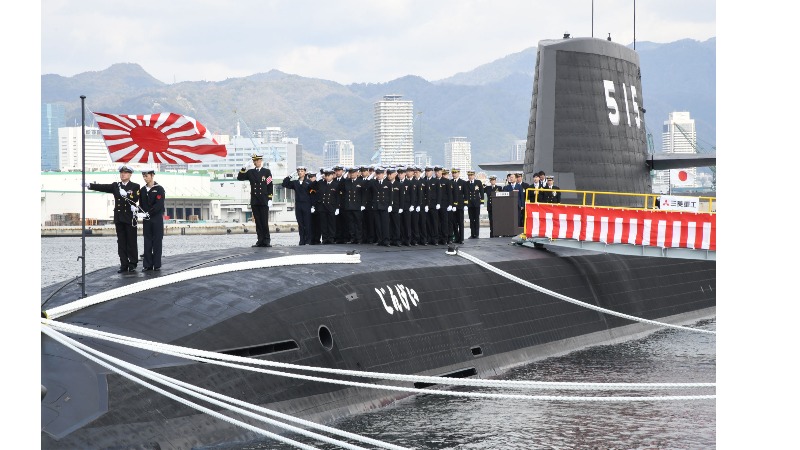
AloJapan.com